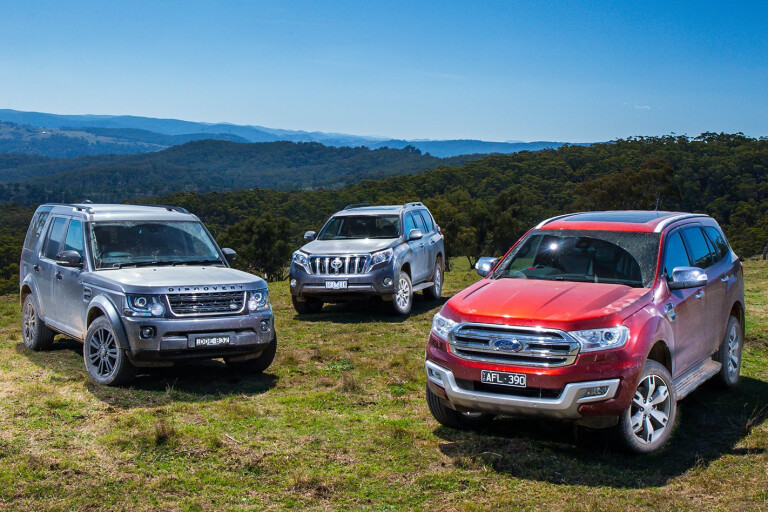
FORD’S Ranger-based Everest is our current 4x4 of the Year. It took out that title as a mid-range ($61K) ‘Trend’ off the back of impressive on- and off-road performance and a comprehensive equipment list that lacks little bar sat-nav, which is available as an option on the Trend.
Pay another $16K over the Trend and you get the $77K Titanium, which, despite having a huge equipment list, puts it near the price of a top-spec $84K Prado Kakadu and $85K Discovery SDV6.
The question is, can a ute-based 4x4 wagon developed in Australia match it with the best Prado and the more powerful of the two diesel Discovery models?
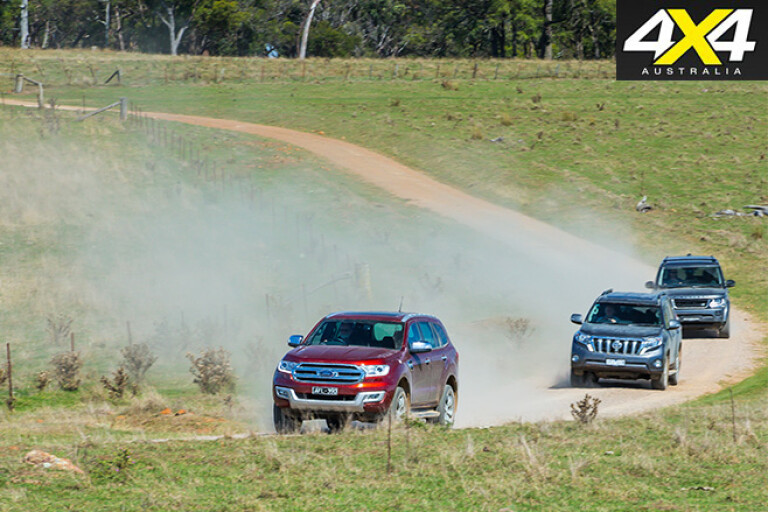
FORD EVEREST TITANIUM
It may have started life as a ute, but the Ford Everest Titanium is now as flash as they come.
JUST in case you didn’t know, the Everest is essentially a wagon version of Ford’s highly successful Ranger ute. Aside from the obvious body change, there are coil springs in place of leaf springs for the rear axle, disc brakes instead drums at the rear, and an ‘active’ full-time 4x4 system rather than the Ranger’s more utilitarian part-time system.
 The wheelbase has also been reduced from the Ranger’s extraordinarily long 3220mm (which is even longer than a Toyota LC79 cab-chassis) to 2850mm, which is the same as a Toyota LC200 (still very long).
The wheelbase has also been reduced from the Ranger’s extraordinarily long 3220mm (which is even longer than a Toyota LC79 cab-chassis) to 2850mm, which is the same as a Toyota LC200 (still very long).
POWERTRAIN AND PERFORMANCE
THE EVEREST shares the 2015 face-lifted Ranger’s 3.2-litre inline five-cylinder diesel engine. Changes from the original Ranger engine include a smaller, more efficient turbo for faster spool-up, a more sophisticated higher-pressure common-rail fuel system, and other changes to the cylinder head designed to improve engine NVH.
What the Everest has that the Ranger lacks is SCR pollutant-reducing technology, which allows the Everest to meet upcoming Euro 6 emission regulations. The Everest’s maximum power of 143kW is 4kW less than the Ranger, although torque max remains
at a solid 470Nm, which comes on-stream at a low 1750rpm.
Thanks to its strong low-rpm power and five-cylinder design, the Everest’s engine has a nicely relaxed low-revving gait on the highway, despite having the shortest gearing of the three wagons here. It’s not as refined as the Kakadu’s new 2.8 or the Discovery’s V6, but it’s still a generally polished engine. The Everest’s 3.2 is the largest-capacity engine here, but it can’t match the heavier bi-turbo Discovery for pedal-to-metal performance; although, it does have the wood on the slightly lighter but taller-geared Kakadu.
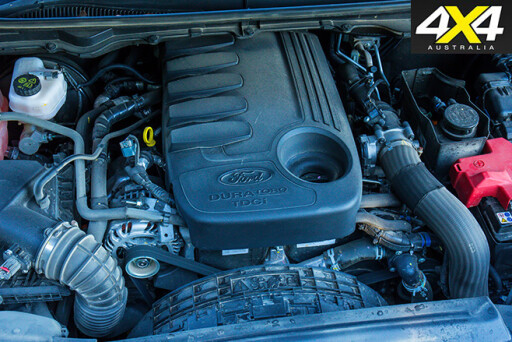 The Everest comes with a six-speed automatic transmission, which is the only gearbox option for the Ford wagon. It offers smooth and decisive shifting and has a closer spread of gears than the new six-speed in the Kakadu.
The Everest comes with a six-speed automatic transmission, which is the only gearbox option for the Ford wagon. It offers smooth and decisive shifting and has a closer spread of gears than the new six-speed in the Kakadu.
ON-ROAD RIDE AND HANDLING
FORD’S engineers have done a good job on the Titanium’s on-road dynamics. Despite its weight, height and off-road-capable suspension, it feels quite sporty through corners.
What part the Watt’s linkage rear-axle location (instead of a simpler Panhard rod) plays is difficult to say, but the whole thing works nicely – even if the live axle at the rear can make its presence felt through bumpy corners. On the flip-side, the Titanium’s ride is a little sharper than the plush-riding Kakadu or even the Discovery. That the Titanium is on 20-inch tyres wouldn’t help here.
Like the facelifted Ranger, the Everest has electric power steering, which is exceptionally light at parking speed but firms up nicely at higher road speeds, without ever quite offering the feel and feedback of a good hydraulically assisted system.
OFF-ROAD
THE Everest doesn’t have the front or rear wheel travel of the KDSS-equipped Kakadu, and it can’t match the front travel of the Discovery. However, it has the benefit of a driver-switched rear locker, the performance of which is further enhanced by the fact that engaging it doesn’t cancel the traction control across the front axle.
Like the Discovery, the Titanium also has an ‘active’ electronic self-locking centre diff, whereas the Kakadu has a mechanical limited-slip centre diff that has to be locked by the driver.
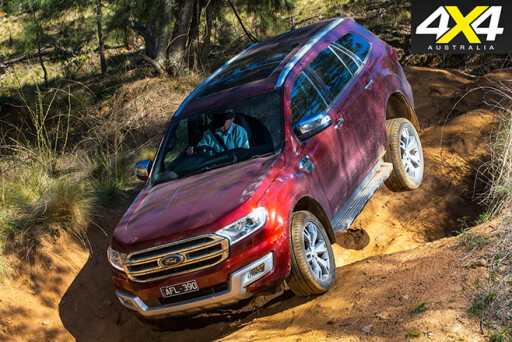 The end result of all this is that the Titanium generally competes well off-road against the other two very well-credentialed vehicles. If anything lets it down in this company it’s the relatively poor vision from the driver’s seat. The sidesteps are also a bit low, but bounce back into shape if bent up, something you can’t say for those on the Kakadu.
The end result of all this is that the Titanium generally competes well off-road against the other two very well-credentialed vehicles. If anything lets it down in this company it’s the relatively poor vision from the driver’s seat. The sidesteps are also a bit low, but bounce back into shape if bent up, something you can’t say for those on the Kakadu.
Not so practical are the Titanium 20-inch wheels and 50-series low-profile tyres. We had two punctures on gravel roads, where small stones penetrated the crown of the tyre’s carcass. However, this can be attributed to the tread design rather than to the aspect ratio. The good news is that the 17s and 18s from the lower-spec models can be fitted to the Titanium. Given these smaller wheels carry Prado-sized tyres, there’s a huge range of options here.
CABIN AND ACCOMMODATION
THE Titanium’s cabin is well-finished and exceptionally well-appointed, but the lack of steering wheel reach adjustment is poor at this asking price. Still, it’s easy for the driver to get comfortable, even if it takes some time to get used to the Titanium’s fiddly buttons and controls.
Life in the backseat matches the Prado, but it’s not as good as the Discovery – the Titanium has the most cramped third row. On the plus side, the space behind the third row is better than the Kakadu when the third row is deployed.
 PRACTICALITIES
PRACTICALITIES
THE Everest is rated to tow 3000kg, so that’s 500kg more than the Kakadu and 500kg less than the Discovery. The Titanium, despite being the heaviest Everest, has a decent payload – even better on paper than the Discovery SDV6.
Not so good is the 80-litre fuel capacity, especially as the Everest engine isn’t as thrifty as it could be. The aforementioned 20-inch wheels also do nothing to enhance the Titanium’s practicality.
SPECS
Engine: DOHC 20-valve 5-cyl turbo-diesel
Capacity: 3.2-litre (3198cc)
Power: 143kW @ 3000rpm
Torque: 470Nm @ 1750- 2500rpm
Gearbox: 6-speed auto
4X4 System: full-time, dual-range
Crawl Ratio: 38.61
Construction: separate chassis
Front suspension: independent/coil springs
Rear suspension: live axle/coil springs
Wheel/tyre spec: 265/50R20 107T
Kerb Mass: 2495kg
GVM: 3100kg
Payload: 605kg
Towing capacity: 3000kg
Seating capacity: seven
Fuel tank capacity: 80 litres
ADR fuel claim: 8.5L/100km
Test consumption: 13.1L/100km
Touring range*: 560km
Price: $76,990
*Based on test consumption and 50km ‘safety margin’.
LAND ROVER DISCOVERY SDV6
The Discovery SDV6 is unique here thanks to V6 bi-turbo-diesel, eight-speed automatic and fully independent suspension.
WHAT you see here is a Discovery SDV6. More specifically, a Discovery SDV6 SE, the lower of the SDV6 specifications, which starts at $84,880. That’s an $8K jump on the Everest Titanium, but on par with the Prado Kakadu.
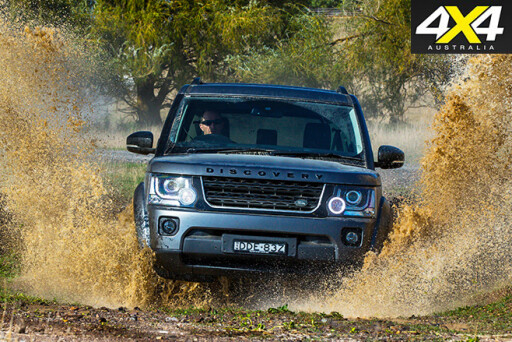 The current Discovery is heavily based on the Discovery 3, so is in effect the end-product of 13 years of continual evolution and is now close to the end of its product life.
The current Discovery is heavily based on the Discovery 3, so is in effect the end-product of 13 years of continual evolution and is now close to the end of its product life.
An all-new, considerably lighter Discovery built on an aluminium monocoque, as per the current Range Rover and RR Sport, should be here mid-to-late 2017 to replace the current (and heavy) steel separate-chassis model.
POWERTRAIN AND PERFORMANCE
THE SDV6 designation means this Discovery has the more powerful of the two bi-turbo V6 diesel engines, which claims 183kW and 600Nm. The less expensive TDV6 develops 155kW and 520Nm, but is mechanically identical to the SDV6 – the difference being in the tuning software.
Despite the SDV6 being the heaviest vehicle here – 150kg more than the already heavy Titanium – its power and torque figures easily outmuscle the Titanium’s 143kW/470Nm and the Kakadu’s modest 130kW/450Nm.
The SDV6 does this off the back of having two turbos rather than the single-turbo arrangements of the Titanium and the Kakadu. The SDV6’s two turbos are of a different size and type, with a larger variable-vane unit and a smaller fixed-vane unit working together to optimise performance. The larger turbo cleverly takes care of most of the driving duties, while the smaller turbo only joins to assist the main turbo on wider throttle openings when top-end power is required.
 The SDV6 backs up the strongest performance here with the best refinement, something enhanced by its smooth and very smart eight-speed ZF gearbox. It’s clearly the best gearbox of the three by a noticeable margin.
The SDV6 backs up the strongest performance here with the best refinement, something enhanced by its smooth and very smart eight-speed ZF gearbox. It’s clearly the best gearbox of the three by a noticeable margin.
The only downside is that the SDV6 is also the thirstiest of the three, something that’s inevitable given it is the biggest, heaviest and most powerful vehicle here. Mind you, it’s not far behind the Titanium; although, like the Ford, it has a too-small fuel tank for remote-area driving.
ON-ROAD RIDE AND HANDLING
THE Discovery may be the heaviest vehicle in this company, but it’s also the only one with fully independent suspension. On tight winding roads the Discovery’s hefty weight makes its presence felt most noticeably, while the fully independent suspension does its best work through bumpy corners.
On a smooth road the Discovery can’t match the sportier feel of the Titanium, but otherwise it’s the best all-round-handling vehicle of this three. Part of its advantage is due to its lower on-road ride, something it can get away with as its air-spring suspension can be significantly jacked up for off-road use – unlike the Titanium (fixed-height suspension) and the Kakadu (which only has a small height adjustment at the rear).
The SDV6’s relatively low-profile 255/55R19 tyres no doubt help to sharpen its precise steering, but they also add a somewhat harsh edge to the ride quality at lower speeds on rough roads. This is the only blot on the Discovery’s ride, which is generally better than the Titanium’s but not quite up to the plushness of the Kakadu’s.
OFF-ROAD
THE height-adjustable suspension is one of the SDV6’s major off-road advantages here. Jacked up for off-road use, it sits a good deal higher than the other two. The negative side of this is that ride quality isn’t as compliant as it is on the lower settings, given the increased tendency for the suspension to top out.
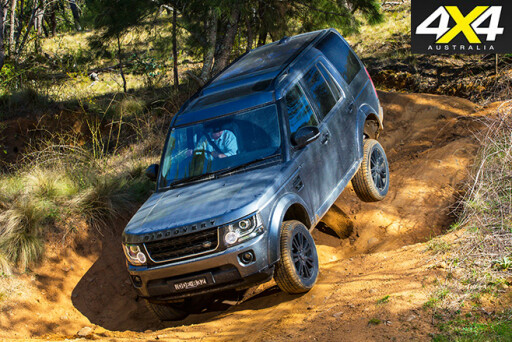 The Discovery has the smartest and most effective 4x4 system, at least when it’s fitted with the $1060 optional rear locker, which isn’t standard on any Discovery – top-spec HSE models included. The locker works wonders for the SDV6 off-road, especially on rutted and broken ground where wheel travel becomes an issue.
The Discovery has the smartest and most effective 4x4 system, at least when it’s fitted with the $1060 optional rear locker, which isn’t standard on any Discovery – top-spec HSE models included. The locker works wonders for the SDV6 off-road, especially on rutted and broken ground where wheel travel becomes an issue.
Best of all, the locker doesn’t require driver switching and is fully integrated with the other chassis control systems, and once engaged it keeps the electronic traction active on the front axle. The Discovery’s other off-road trump card is the vision from the driver’s seat, which is way better than the Titanium and noticeably better than the Kakadu.
CABIN AND ACCOMMODATION
THE Discovery’s cabin is the biggest and most versatile here thanks to the fact that it has the only third row seats suitable for larger adults, and that all the seats fold individually and dead-flat for multiple cargo/seating configurations.
The SDV6 has a supportive driver’s seat, adjustable armrests, and the previously mentioned good vision. While it feels luxurious, thanks in part to its leather seats, the standard equipment is poor compared to the Titanium and the Kakadu. Not even sat-nav is standard in the SE, although it is available as an option.
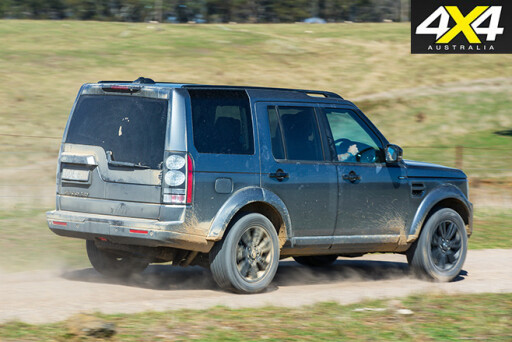 PRACTICALITIES
PRACTICALITIES
AS EVER, the weakness of the Discovery is in the wheel and tyre spec. The standard high-speed-rated 255/55R19s are too vulnerable to off-road damage, while aftermarket tyre choice is still limited.
The 82.3-litre fuel capacity is also too small, but relatively easily attended to via aftermarket enhancement, which is good across the board for the Discovery. At 3500kg the Discovery’s maximum tow rating is the best here, while its 600kg payload is similar to the Titanium’s and well ahead of the Kakadu’s.
SPECS
Engine: DOHC 24-valve V6 bi-turbo-diesel
Capacity: 3.0-litre (2993cc)
Power: 183kW @ 4000rpm
Torque: 600Nm @ 2000rpm
Gearbox: 8-speed auto
4X4 System: full-time dual-range
Crawl Ratio: 51.11
Construction: separate chassis
Front suspension: independent/air springs
Rear suspension: independent/air springs
Wheel/tyre spec: 255/55R19 111V
Kerb Mass: 2640kg
GVM: 3240kg
Payload: 600kg
Towing capacity: 3500kg
Seating capacity: seven
Fuel tank capacity: 82.3 litres
ADR fuel claim: 8.5L/100km
Test consumption: 13.9L/100km
Touring range*: 542km
Price: $84,880
*Based on test consumption and 50km ‘safety margin’.
TOYOTA PRADO KAKADU
The top-spec Prado Kakadu isn’t just loaded with luxury and convenience kit, it’s also very different mechanically to lesser Prados.
THE Prado Kakadu will set you back $84,490, plus on-road costs. For that price it comes fully loaded with a vast array of luxury, convenience, safety and special mechanical features, with only premium paint an extra cost. Compare that to the Discovery SDV6 SE, which starts at the same price but needs a boot-full of options to come up to what the Kakadu has standard.
 The significant mechanical features that set the Kakadu apart from the rest of the Prado range include a rear diff lock, terrain-specific settings for the 4x4 system, height-adjustable rear suspension, variable suspension damping and what Toyota calls ‘Crawl Control’, which is like hill-descent control but works both on flat ground and up hills.
The significant mechanical features that set the Kakadu apart from the rest of the Prado range include a rear diff lock, terrain-specific settings for the 4x4 system, height-adjustable rear suspension, variable suspension damping and what Toyota calls ‘Crawl Control’, which is like hill-descent control but works both on flat ground and up hills.
Importantly, the Kakadu has Toyota’s Kinetic Dynamic Suspension System (KDSS) as standard, although this is also found on the VX, which is one spec level down from the Kakadu. KDSS is a relatively simple (essentially hydro-mechanical) means of varying the sway-bar tension to give both flatter on-road handling and more wheel travel off-road – a best-of-both-worlds outcome.
POWERTRAIN AND PERFORMANCE
THE Kakadu is powered by Toyota’s 2.8-litre ‘global’ diesel that is the mainstay of the new-gen HiLux. This new smaller-capacity diesel and its attendant six-speed auto – the only gearbox available with the Kakadu – replaced the outgoing 3.0-litre diesel and five-speed auto in the Prado late last year.
This new diesel brings more torque than the 3.0-litre (450Nm v 410Nm) but an insignificant increase in power (up just 3kW), so the performance improvement isn’t great. Nor does the six-speed gearbox help the overall performance, as it just adds a second and taller overdrive ratio rather than tightening up the ratio gaps in the
lower gears.
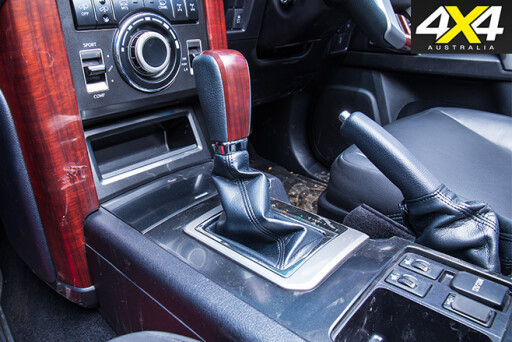 However, the 2.8-litre engine brings much-improved refinement, which is better than both the 3.0-litre it replaces and the Titanium’s 3.2, which can be a bit gruff at times in comparison. Still, the 2.8 is no match for the Discovery’s V6 for refinement, and it’s behind both engines in performance – especially the SDV6.
However, the 2.8-litre engine brings much-improved refinement, which is better than both the 3.0-litre it replaces and the Titanium’s 3.2, which can be a bit gruff at times in comparison. Still, the 2.8 is no match for the Discovery’s V6 for refinement, and it’s behind both engines in performance – especially the SDV6.
The Kakadu’s new six-speed automatic transmission can’t match the finesse of the Discovery’s eight-speed ZF and doesn’t work as well as the Titanium’s six-speed, even if it matches it in general refinement.
The trouble with the Kakadu is that the sixth gear can be too tall at times on undulating country roads, which has the gearbox changing up and down a bit between fifth and sixth. This doesn’t happen with the Titanium.
ON-ROAD RIDE AND HANDLING
EVEN with KDSS, the Kakadu tails the field in regards to on-road handing, especially with its tendency to understeer when pushed hard through tight corners. It’s not behind by much, mind you, but still the tail-ender. The Kakadu-specific variable damping doesn’t make a worthwhile difference, as ‘Sport’ mode only seems to firm up the ride without reducing understeer.
At least ride quality is very good and generally the best; although, on bumpier roads the Kakadu’s rear live axle can’t match the smoothness or control of the SDV6’s independent rear suspension.
OFF-ROAD
THE Kakadu’s supple, long-travel suspension is also the key to its considerable off-road prowess. To give you an idea of the benefit of KDSS, a non-KDSS Prado has 465mm of rear-wheel travel; a KDSS-equipped Prado VX has 565mm, a handy improvement in anyone’s language.
 In terms of the off-road-specific Kakadu kit, the rear height adjustment is handy even if it doesn’t jack up the vehicle all that much. The low-range-only ‘Multi Terrain Select’ can also be handy, as there is a difference in the programs. However, in a silly arrangement, when you select low-range (and separately lock the centre diff) you then have to select an MTS program, as there is no default program that automatically activates on low-range selection.
In terms of the off-road-specific Kakadu kit, the rear height adjustment is handy even if it doesn’t jack up the vehicle all that much. The low-range-only ‘Multi Terrain Select’ can also be handy, as there is a difference in the programs. However, in a silly arrangement, when you select low-range (and separately lock the centre diff) you then have to select an MTS program, as there is no default program that automatically activates on low-range selection.
The rear locker also has a downside, as when it’s engaged it cancels the ETC on both axles – not just the rear. The jury is also still out on the benefit of ‘Crawl Control’. All of this means the Kakadu’s ability off-road is more about its KDSS-equipped chassis, than all the Kakadu-specific add-ons.
CABIN AND ACCOMMODATION
AS with any Prado, the cabin is comfortable, spacious and practical – it may not rate quite as highly in the latter two areas as the SDV6 perhaps, but it either matches or betters the Titanium in most departments. Its electric tilt-and-reach steering wheel adjustment is luxurious compared to the Everest, as is the smart-key entry and push-button start. At the other end of the vehicle, the Kakadu’s third row works better than the less roomy equivalent in the Everest.
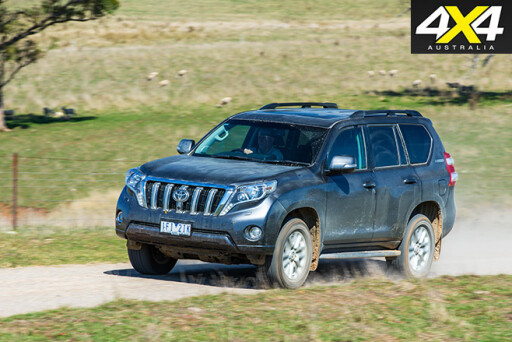 PRACTICALITIES
PRACTICALITIES
A big win for the Prado is its 150-litre fuel capacity, nearly double that of the Everest and Discovery and a major bonus for remote-area touring.
Practical wheel and tyre spec has always been a Toyota given. Even if you aren’t happy with Kakadu’s 18s, it’s a straightforward swap to 17s (either OEM or aftermarket).
SPECS
Engine: DOHC 16-valve 4-cyl turbo diesel
Capacity: 2.8-litre (2755cc)
Power: 130kW @ 3400rpm
Torque: 450Nm @ 1600- 2400rpm
Gearbox: 6-speed auto
4X4 System: full-time dual- range
Crawl Ratio: 36.1:1
Construction: separate chassis
Front suspension: independent/coil springs
Rear suspension: live axle/ coils+height adjust.
Wheel/tyre spec: 265/60R18 110H
Kerb Mass: 2435kg
GVM: 2900kg
Payload: 465kg
Towing Capacity: 2500kg
Seating capacity: seven
Fuel tank capacity: 150 litres
ADR fuel claim: 8.0 litres/100km
Test consumption: 12.3 litres/100km
Touring range*: 1170km
Price: $84,490
*Based on test consumption and 50km ‘safety margin’.
WHAT YOU GET
TOYOTA PRADO KAKADU
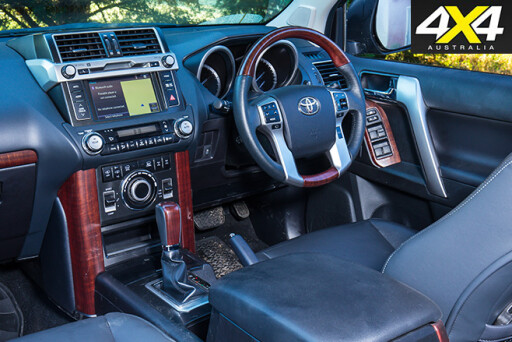 KAKADU is loaded with kit: ‘smart key’ entry; push-button start; leather; electric seat and tilt-and-reach steering adjust; heated front/second-row seats; three-zone climate control; power-fold third row; seven airbags; sat-nav; rear-view camera; Bluetooth; AUX/iPod/USB inputs; multiple power outlets including 220V; sunroof; rear parking sensors, auto headlights and wipers; 17-speaker audio system; rear-seat DVD entertainment; adaptive cruise; blindspot monitoring; rear cross-traffic alert; autonomous braking; variable suspension damping; height-adjustable rear suspension; Multi-Terrain Select; Crawl Control; and a rear diff lock.
KAKADU is loaded with kit: ‘smart key’ entry; push-button start; leather; electric seat and tilt-and-reach steering adjust; heated front/second-row seats; three-zone climate control; power-fold third row; seven airbags; sat-nav; rear-view camera; Bluetooth; AUX/iPod/USB inputs; multiple power outlets including 220V; sunroof; rear parking sensors, auto headlights and wipers; 17-speaker audio system; rear-seat DVD entertainment; adaptive cruise; blindspot monitoring; rear cross-traffic alert; autonomous braking; variable suspension damping; height-adjustable rear suspension; Multi-Terrain Select; Crawl Control; and a rear diff lock.
LAND ROVER DISCOVERY SDV6
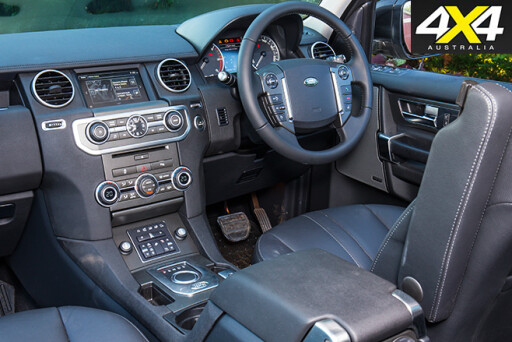 THE SDV6 SE is mid-spec in the Discovery range and comes with eight airbags; leather; electric seat adjust; manual tilt-and-reach steering wheel adjustment; push-button start; dual-zone climate control; cruise control; rear parking sensors; rear-view camera; Bluetooth, USB and iPod connectivity; digital radio; 11-speaker audio; Xenon headlights and LED daytime running lamps. The SDV6 SE has 19s as standard.
THE SDV6 SE is mid-spec in the Discovery range and comes with eight airbags; leather; electric seat adjust; manual tilt-and-reach steering wheel adjustment; push-button start; dual-zone climate control; cruise control; rear parking sensors; rear-view camera; Bluetooth, USB and iPod connectivity; digital radio; 11-speaker audio; Xenon headlights and LED daytime running lamps. The SDV6 SE has 19s as standard.
Beyond that there is a huge range of options, including the automatic rear locker ($1060); sunroof ($3860); auto-dimming Xenon headlights ($1800); rear air-con ($1590); adaptive cruise control ($2300); rear cross-traffic and blindspot monitoring ($700); smart key entry ($2100); sat-nav ($3240); and rear-seat DVD entertainment ($4100). Most of these options are needed to bring the SDV6 to equipment parity with the Titanium and Kakadu.
FORD EVEREST TITANIUM
 The Everest Titanium has leather; electric seat adjust; power-fold third row; seven airbags; front and rear parking sensors; dual-zone climate; rain-sensing wipers; cruise control; eight-inch touchscreen; sat-nav; rear-view camera; park assist; Bluetooth, AUX, iPod, and USB connectivity; multiple power outlets including 230V; power tailgate; and a sunroof.
The Everest Titanium has leather; electric seat adjust; power-fold third row; seven airbags; front and rear parking sensors; dual-zone climate; rain-sensing wipers; cruise control; eight-inch touchscreen; sat-nav; rear-view camera; park assist; Bluetooth, AUX, iPod, and USB connectivity; multiple power outlets including 230V; power tailgate; and a sunroof.
High-end safety equipment includes blind-spot monitoring; rear cross-traffic alert; tyre-pressure monitoring; adaptive cruise; autonomous braking; and lane-departure warning.
The Titanium rides on 20s and also has auto-dipping HID headlights, LED running lamps, a rear diff lock and sidesteps.
THE VERDICT
THERE are many ways to run the ruler over these three vehicles: performance; on-road handling; refinement; off-road ability; cabin space; equipment value; general practicality; and safety.
No vehicle here wins on all counts, but the SDV6 is outright first in performance, refinement, cabin space and off-road ability – provided the optional rear locker is fitted. It’s as good as it gets in terms of on-road handling.
But, being an old platform, the Discovery only achieves four out of five stars in the official ANCAP safety test, whereas the other two are five-star-rated. That doesn’t necessarily mean the Discovery is less safe once you have an accident, it just has less safety add-ons.
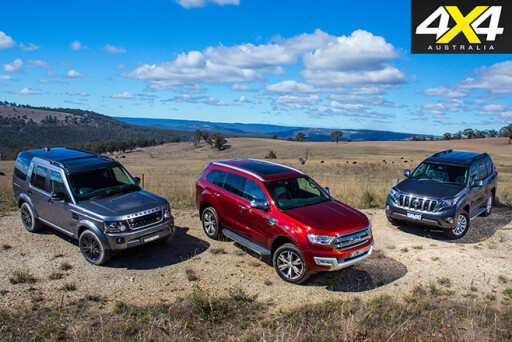 Despite being the best core vehicle here, the Land Rover Discovery is weak on value for money if you’re after equipment. In fact, to option the SDV6 up to Kakadu- or Titanium-spec you’re looking at more than $100K in total. If it’s the Discovery you’re after, then it’s best to start with the $70K TDV6 and option from there given that SDV6 performance isn’t hard to achieve.
Despite being the best core vehicle here, the Land Rover Discovery is weak on value for money if you’re after equipment. In fact, to option the SDV6 up to Kakadu- or Titanium-spec you’re looking at more than $100K in total. If it’s the Discovery you’re after, then it’s best to start with the $70K TDV6 and option from there given that SDV6 performance isn’t hard to achieve.
In this company the Kakadu wins hands-down in all-round practicality and is equal first in safety, but if it’s a leather-equipped luxury Prado you’re after you’d probably be better off with a VX. It doesn’t have all the bells and whistles of the Kakadu, but it’s not weighed down with stuff you don’t want. And it’s $10K cheaper than a Kakadu!
The Titanium’s trump card is its equipment, where it’s a standout at the price. Importantly, all of the Titanium’s extra kit over the Trend (bar the 20s) are meaningful additions.
This is something you can’t say about the extra kit of the Kakadu versus the VX. And it’s easy enough to ditch the Titanium 20s for the 17s or 18s on lower-spec models.

COMMENTS